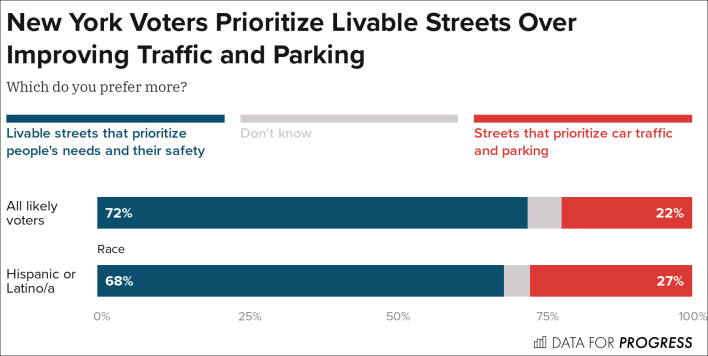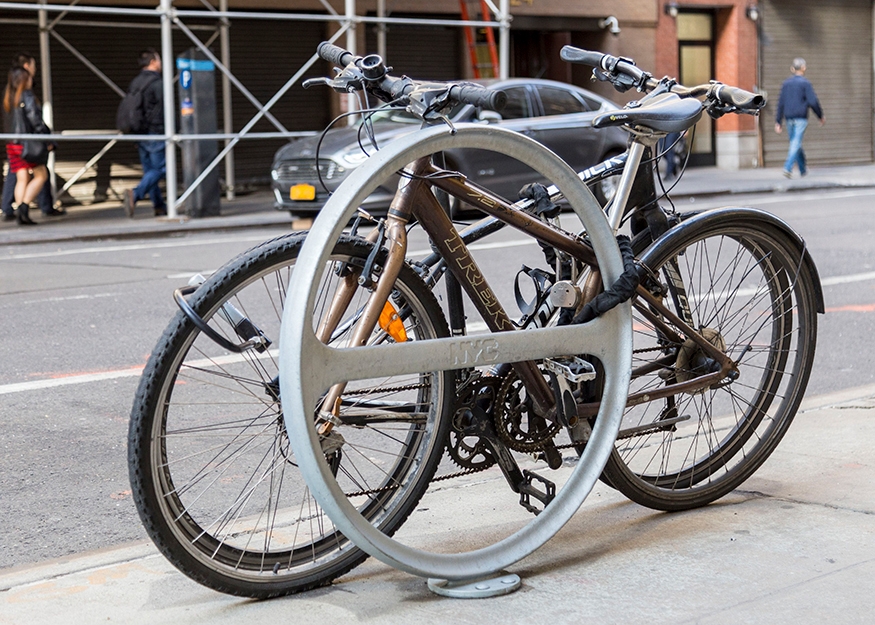Cycling activists were in a scramble to organize opposition to a Senate bill that surprisingly passed its first hurdle on Monday despite an intent to make it harder for the city to install bike racks and bike lanes.
Sen. Luis Sepulveda's bill, S6929, passed the Cities Committee by a vote of 5-1, with Manhattan Sen. Brad Hoylman opposing. The Bronx senator's bill would "require the New York City Department of Transportation to provide electronic and written notification to the community board and local elected officials when there will be a new bicycle lane or rack constructed or removed."
It also requires the DOT to "provide a presentation to the community board and consider comments from the community before implementation of said plan."
It is sponsored in the Assembly by Chantal Jackson, who received lots of negative reaction on social media last year when she introduced the bill.
Does @ChantelJ2020 know there already is a process for community feedback for bike lanes and bike rack placement? Why gum up the process even more - and legislating DOT sending her an e-mail to notify her of a community board meeting - really? https://t.co/DUY9cz4E6d
— Lucia :D 飞飞 (@LuciaDLite) May 30, 2021
The bill is so far-fetched — after all, the DOT is already required by city law (aka "the Fidler rule") to notify community boards, which often take advantage of said notification to block life-saving bike infrastructure — that many advocacy groups did not even bother to take a public stance against it. A reps for Bike New York told Streetsblog on Monday that the group would now prepare full testimony in hopes of stalling the bill so that it does not make it to the Senate floor or pass the Assembly Cities Committee, where it has not been taken up yet.
The bill's passage comes at a time when the city is itself searching for ways to streamline the public notification process for bike lanes. Last year, then-Council Member Antonio Reynoso introduced a bill that would repeal the notorious Fidler rule, which enshrined in law that bike lanes are even more disruptive than "major transportation projects,” and, as such, needed extra review. Reynoso's bill would once again classify bike lanes as major transportation projects, which, despite the name, can be undertaken merely by giving the local Council member 10 days to submit comments and 30 days for a local community board to ask for (but not necessarily get) a presentation on the project.
"This Senate bill feels like an attempt to bigfoot the city exactly when the city is trying to streamline the process," said one legislative source. "The whole thing is boneheaded." Hoylman's office declined to explain his vote, beyond saying that his opposition "speaks for itself."
The Albany bill would likely slow the progress that Mayor Adams and the DOT has promised to make. The city is in the middle of installing 10,000 bike racks by the end of this year, and Adams has promised to build even more protected bike lanes than he is required by law to construct.
DOT did not get back to us on deadline. (Update: On Tuesday morning, agency spokesman Vin Barone said only, "We are reviewing this legislation.")
For his part, Sepulveda reminded opponents that he is "the most avid cyclist in the senate" — though Streetsblog pointed out that Sen. John Liu of Queens has also made the same claim ("Liu is in better shape than I am, I admit," Sepulveda said.)
And he also pointed out that the bill also covers the removal of a bike lane or bike rack — though such occurrences are not only rare, but have virtually never attracted the ire of community boards, as have the installation of measures to encourage cycling.
Sepulveda claimed that his bill is needed because there is currently not enough notification to "the community," citing a time when "constituents wake up and find that entire blocks of parking have been removed without adequate notion." When reminded that those constituents' community boards and council members were likely notified, he said that's why his bill — which would add notification of Assembly members and Senators — was so necessary.
Still, it is unlikely that adding two more elected officials to the notification process is going to suddenly engage people who have already ignored notifications from their local community board or council member.
"So that is why we need to engage them," he said. "To opponents of this bill, I say, 'What's wrong with more notification?' If you want people who are not cyclists to want to respect the issue of bike lanes and understand that a transition to more biking will bring a healthier environment, the loss of pollution, etc., you can't shove this down their throats."
Streetsblog reminded Sepulveda that many bike riders, pedestrians, seniors, kids, joggers, tourists and transit users feel that cars were essentially shoved down their throats without any community board hearings when their owners were allowed to seize six Central Parks' worth of public space for private vehicle storage. The senator said he would consider created a similar bill to require notification if the city intends to remove or add parking.
"But people only come to me when the city wants to remove parking," he said.
At least one thing about Sepulveda's bill appears to be willfully ignorant of current circumstances, in that it claims that "community boards and community members alike are becoming increasingly concerned about the implementation of incoming bicycle lanes and racks."
In fact, in the 11 years since the Fidler rule went into effect, New Yorkers have embraced cycling and livable streets, and battles against every single bike project are far more rare. Last year, in fact, polling from Data For Progress, showed that 58 percent of New Yorkers support changing streets to make it safe enough for children to bike to school, even if it meant removing parking or closing streets to car traffic.
The same survey showed overwhelming support for "livable streets" over "street that prioritize car traffic and parking."

The DOT’s own polling from 2020 showed that only 13 percent of New Yorkers were opposed to allocating street space for protected bike lanes, with a whopping 68 percent in support of the idea (see page 37).
And in a Transportation Alternative poll last year, 63 percent of residents said they support using public money to expand Citi Bike.
To tell your senator you opinion on the Sepulveda bill, click here and scroll to the "Do you support this bill" box on the right.






